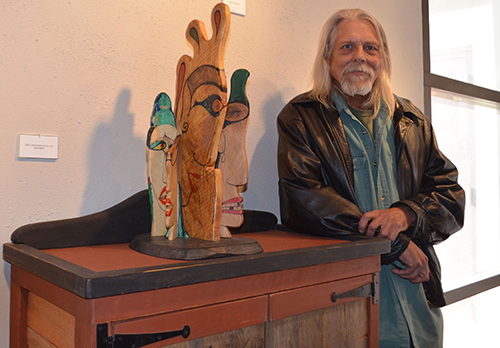
Photo: Margaret McKinney/Highlands University
Las Vegas artist Dia Atman’s exhibit I Sing the Body Eclectic is in the Ray Drew Gallery through Feb. 16, with an artist’s reception Feb. 16 from 2 — 4 p.m.
Las Vegas, N.M. — The New Mexico Highlands University Ray Drew Gallery presents Dia Atman’s exhibit I Sing the Body Eclectic through Feb. 16, with an artist’s reception Feb. 16 from 2 — 4 p.m.
The Ray Drew Gallery is in the university’s Donnelly Library, 802 National Ave. The gallery is open Monday — Friday 8 a.m. — 5 p.m., and on Saturday and Sunday from 1 — 5 p.m.
Atman is a 25-year Las Vegas resident whose studio is near the historic Las Vegas Plaza. His figurative sculptures and cabinets created from reclaimed wood defy simple pigeonholing.
“I invite people to see Dia’s show because it is such a unique, whimsical experience in art that doesn’t fit into traditional categories,” said Bob Read, the curator for the Ray Drew Gallery and the university’s fine art librarian. “He combines the idea of artistic freedom with excellent craftsmanship and has an uncompromising creative vision for his art.”
Atman grew up in the Bay Area and earned his MFA in music from Mills College in Oakland, Calif. Since moving to New Mexico, he has exhibited his work in galleries in Taos, Santa Fe, Silver City, and Las Vegas.
“One of the things I’m interested in addressing in my art is the western schism between art and craft,” Atman said. “I try to make the cabinets more than just furniture. Beauty should be a part of our lives in everyday utilitarian objects.”
Atman calls himself a third-generation recycler of wood. During the Great Depression, his grandfather lost everything and built a house of reclaimed lumber in the hills of Lafayette, Calif. Atman’s father was a builder who also used recycled wood.
Many of Atman’s art pieces evolve from salvaged shipping pallet wood, which can include oak, poplar, ash, walnut and pine. He mills his wood using power and hand tools. Whenever possible, he incorporates vintage hardware into his pieces.
“I try to let the wood tell me what to do. The most successful pieces are the ones that work well with the shape and grain of the wood. I make use of the natural defects in the wood,” Atman said.
His series of “alter” sculptures in the show display human and animal heads, often interacting. He uses rich acrylic paint tones to adorn the sculptures without hiding the grain and texture of the wood.
“I call them ‘alters’ rather than altars because they are not sacred. The concept of playing with the language reinforces the idea that my work is often a lighthearted approach to art,” Atman said.
There are similarities between Atman’s creative process for his original keyboard music and his wooden art pieces.
“I visualize rhythm and patterns in the wood in the same way I think about music. I’m also improvisational and as loose as possible in my music and this carries over into my woodwork,” Atman said.
